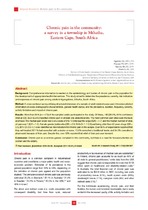| dc.contributor.author | Igumbor, Ehimario U. | |
| dc.contributor.author | Puoane, Thandi | |
| dc.contributor.author | Gansky, Stuart A. | |
| dc.contributor.author | Plesh, Octavia | |
| dc.date.accessioned | 2012-10-02T11:53:10Z | |
| dc.date.available | 2012-10-02T11:53:10Z | |
| dc.date.issued | 2011 | |
| dc.identifier.citation | Igumbor, E.U., Puoane, T., Gansky, S.A & Plesh, O. (2011). Chronic pain in the community: Survey in a township in Mthatha, Eastern Cape, South Africa. Southern African Journal of Anaesthesia and Analgesia, 17(5): 329-337 | en_US |
| dc.identifier.issn | 1027-9148 | |
| dc.identifier.uri | http://hdl.handle.net/10566/432 | |
| dc.description.abstract | Background: Comprehensive information is needed on the epidemiology and burden of chronic pain in the population for
the development of appropriate health interventions. This study aimed to determine the prevalence, severity, risk indicators
and responses of chronic pain among adults in Ngangelizwe, Mthatha, South Africa.
Method: A cross-sectional survey utilising structured interviews of a sample of adult residents was used. Interviews elicited
information on socio-demographic characteristics, general health status, and the prevalence, duration, frequency, severity,
activity limitation and impact of chronic pain.
Results: More than 95% (n = 473) of the sampled adults participated in the study. Of these, 182 [38.5%, 95% confidence
interval (CI): 36.3-42.5%] reported chronic pain in at least one anatomical site. The most common pain sites were the back
and head. The median pain score was 5 on a scale of 0 to 10 [interquartile range (IQR) = 4-7] and the median number of sites
of pain was 1 (IQR = 1-2). Female gender [odds ratio (OR) = 2.6, 95% CI: 1.7-3.9] and being older than 50 years of age (OR =
3.5, 95% CI: 2.6-4.1) were identified as risk indicators for chronic pain in the sample. Over 65% of respondents reported that
they self-treated; 92.1% had consulted with a doctor or nurse, 13.6% consulted a traditional healer, and 34.5% consulted a pharmacist because of their pain. Despite this, over 50% reported that relief of their pain was transient.
Conclusion: Chronic pain is a common general complaint in this community, but there is a need for focused attention on women and the elderly. | en_US |
| dc.language.iso | en | en_US |
| dc.publisher | Medpharm Publications | en_US |
| dc.rights | © 2012 Igumbor, et al; licensee Medpharm Publications. This is an Open Access article distributed under the terms of the Creative Commons Attribution-Noncommercial-No Derivative Works 2.5 South Africa License, which permits unrestricted use, distribution, and reproduction in any medium, provided the original work is properly cited. | |
| dc.subject | Chronic pain | en_US |
| dc.subject | Adults | en_US |
| dc.subject | Prevalence | en_US |
| dc.subject | Public health | en_US |
| dc.subject | Eastern Cape | en_US |
| dc.title | Chronic pain in the community: A survey in a township in Mthatha, Eastern Cape, South Africa | en_US |
| dc.type | Article | en_US |
| dc.privacy.showsubmitter | false | |
| dc.status.ispeerreviewed | true | |
| dc.description.accreditation | Department of HE and Training approved list | en_US |

